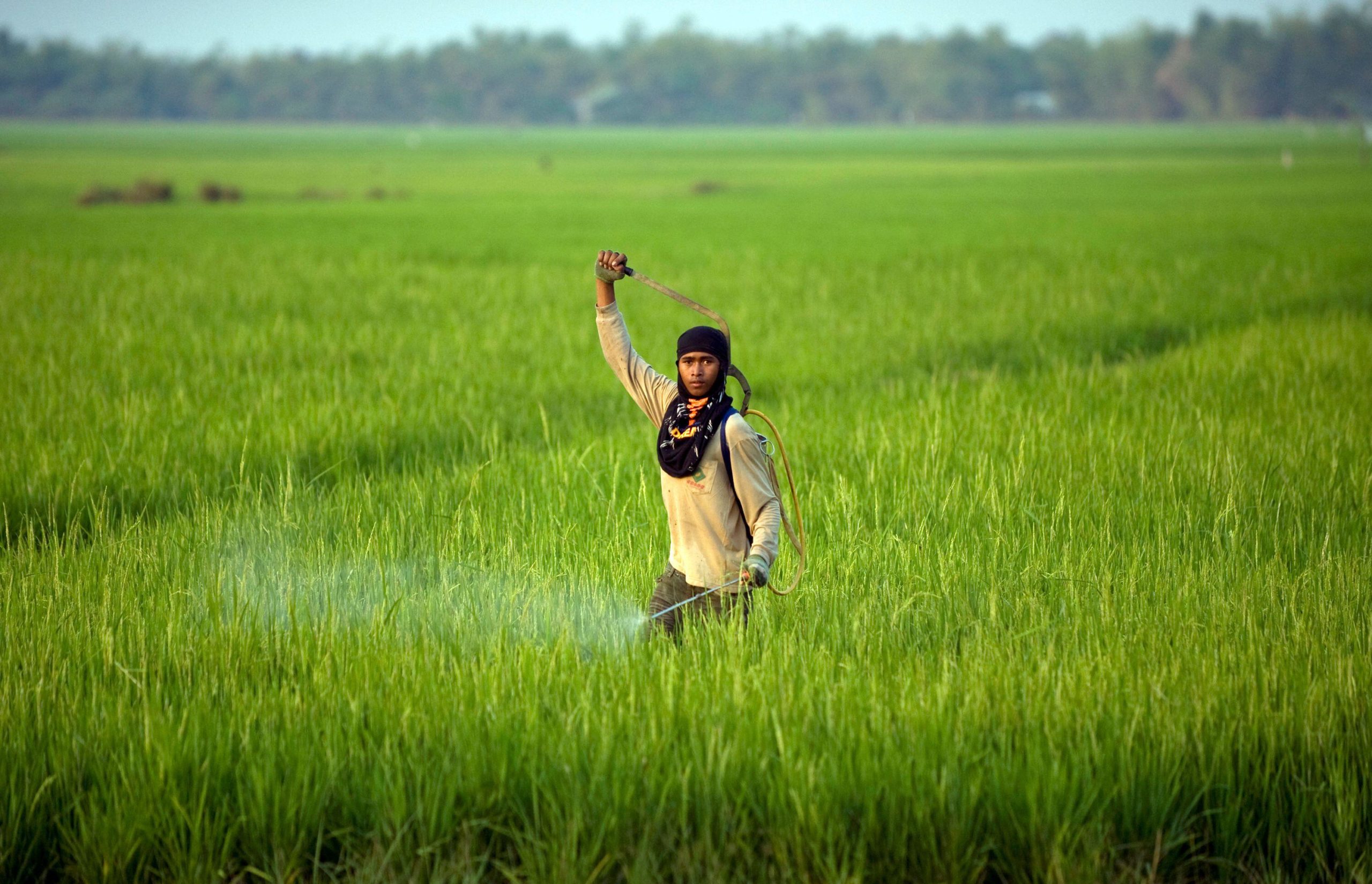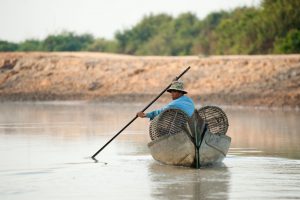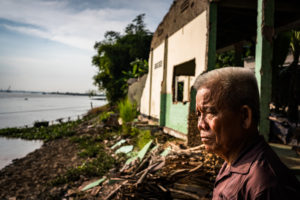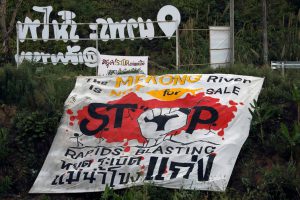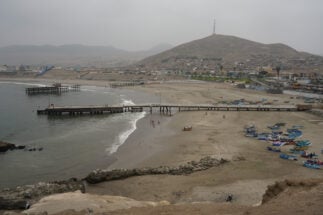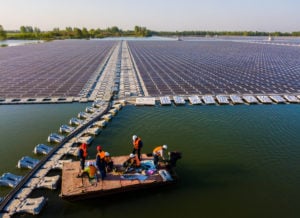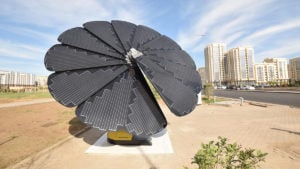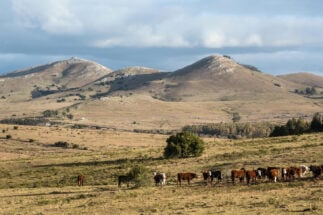“I’ve seen lower yields on my farm each year since maybe 2017 or 2018 – there just isn’t enough water,” says Yoeum Yoeut.
Yoeut, 52, is a lifelong resident of the Baran district in Cambodia’s northwest Battambang province. Her livelihood has always depended on the natural flooding of Tonle Sap lake and its tributaries, but climate change, extreme weather and upstream dams have upended this.
“Last year, the crops just wouldn’t grow the same. My yield was maybe 70% of what I was hoping for – and last year was already worse than 2019. Each year, the rains are harder to predict, there’s less water in the Sangke river and we’re all feeling it,” Yoeut says. She adds that people west of National Road 5, a highway that borders the south of Tonle Sap, “have no water at all any more”.
“They’ve got canals and irrigation ditches, but they run dry before the crops are ready to harvest.”
With no rain for the past six months, Yoeut has been pumping water from the Sangke river, a 250-kilometre tributary flowing in and out of Tonle Sap lake. Using petrol-fuelled pumps and ditches she dug herself, Yoeut diverts water from the Sangke about half a kilometre away to a storage pond.
There was a time, she recalls, when rice could be grown in both the wet and dry seasons. But now during the dry season, from October to April, Yoeut has turned to growing mangoes and other crops that require less water.
“Since Covid-19 though, there’s no market. The price of mango has dropped and there’s no rain yet for rice, so every two days I have to spend 100,000 Cambodian riel [roughly USD 25] on petrol for the pump. I’m struggling to break even.”
Tonle Sap’s irregular pulse
Once the backbone of Cambodia’s economy, agriculture’s share of gross domestic product was 20% in 2019, down from 47% in 1995. But last year Covid-19 stalled other parts of the economy, prompting Hun Sen, prime minister of Cambodia, to encourage a return to the fields in August 2020. The Royal Academy of Cambodia predicted that agriculture might contribute 32% of GDP for the year.
However, dependence on farming is hampered by threats posed by upstream hydropower dams in China and Laos, which have drastically altered the natural rhythms of the region’s water resources.
China has 11 operational dams on its section of the Mekong, known as the Lancang. A further 11 mainstream dams are in various stages of planning and completion through Laos and Cambodia, 10 of which involve some Chinese investment.
Every year, the Mekong floods and reverses the flow of the Tonle Sap river, causing Tonle Sap lake to swell to five times its low-water size and create Asia’s largest lake and freshwater fishery. This natural cycle, or pulse, has come later for the past two years, devastating fisheries and complicating agriculture.
Kong Chhum, 71, has lived in Battambang province – some 70 kilometres from Tonle Sap lake’s shoreline in Thma Koul district – for most of his life. While this dry season has brought Chhum a good rice yield, he is concerned about the irregular seasons.
Chhum’s good fortune is due to his proximity to the Pheas reservoir, at the northeastern tip of Tonle Sap lake. In recent years, the Pheas reservoir has been restored, so that it spans up to 300 hectares in the dry season and 500 hectares during the wet season. It serves nine districts in Battambang, including Thma Koul. For Chhum, this has meant rice crops have become a year-round activity, providing much-needed stability. But other farms across Aek Phnum and Thma Koul districts, many within the Tonle Sap region, have suffered badly from reduced natural flooding.
Communities were fighting each other for water when the streams [branching off the Sangke] began to run dry. There just wasn’t enough for everyone’s farmsKong Chhum
Four years ago, dwindling water resources changed Chhum’s community, as many sought to move closer to the lake. “There have been conflicts… communities were fighting each other for water when the streams [branching off the Sangke] began to run dry. There just wasn’t enough for everyone’s farms,” says Chhum.
The problem is compounded by the growing threat to fish populations from upstream dams. Previously, fishing could supplement farming and offset financial and subsistence losses caused by extreme weather events. Now, all of Cambodia’s water resources – which sustain both fishing and farming around the Tonle Sap basin – are at risk, posing a problem for the 4.85 million Cambodians estimated to live across the eight provinces that make up the Tonle Sap region.
‘No fish, floods, tourists or migrant work’
“The pandemic, the low flood levels, the rising costs associated with fishing and farming – it’s all had a negative impact on communities here,” says Hou Savy, head of the Kampong Khleang Ecotourism Association in Siem Reap province. He says he has seen his community struggle through the Covid-19 pandemic, but long before the virus, they faced another silent and distant threat.
“People are very worried about the dams. While Covid-19 has killed tourism and even the price of produce, the dams are killing the Tonle Sap. People used to be able to migrate to Thailand where there’s always work, but not now,” he says.
Without migration or tourism, Savy says, Kampong Khleang district residents are paying more attention to the recent dip in water levels.
“This is not a distant threat – it’s happening now. The low water levels have been a problem for years, but now there isn’t even a market for whatever yields we manage to produce,” he says.
“No fish, no floods, no tourists and no migrant work – it’s really hard. I’ll sell my fish or my crops at low market prices,” he adds. “The prices we’re selling at aren’t acceptable, but if there are buyers, we’ll sell. We all have debts to pay and they [the financial institutions] want their interest.”
If I can’t farm, I don’t know what I’ll do – it’s the same for everyone here.Ly Map
Savy’s debts cost USD 400 per month in interest. But he is not alone in having to pay back loans taken to fund his farming activities: the increased cost of farming, particularly the acquisition of water for irrigation, eat away at many farmers’ profits.
Ly Map also lives in Kampong Khleang district. Her dry-season rice crops have failed since 2017 and now even the wet-season harvests are barely enough to pay back the bank.
“I took out a USD 10,000 loan for my farm, but these days I’m using more fertiliser and pesticides. The yields are getting worse. I have about 40 hectares, but I rent a lot of that from other people,” she says. “I’m losing almost USD 7,000 on a yearly yield that brings in around USD 23,000. I still have to pay interest on my loan,” she said.
On the floodplain, more locals are coming to believe their problems start upstream. “These days, people say it’s the dams, the ones in China, that are stopping the water… If I can’t farm, I don’t know what I’ll do – it’s the same for everyone here,” Map says. “There’s no support, not even from the NGOs.”
Irrigating a nation
The growing reliance on, and subsequent impact of, irrigation through the Tonle Sap region is difficult to measure. A 2019 study suggested that nearly 30% of farms nationwide were dependent on irrigation, although the study’s disaggregation of data by crop type rather than region makes it difficult to know how the Tonle Sap region’s reliance on irrigation has changed.
In 2019, the worst drought in a century was recorded. After this, in February 2021 the Mekong River Commission, a regional advisory board of representatives from Cambodia, Laos, Thailand and Vietnam, reported that low water levels on the river – which feeds into Tonle Sap lake and supports the agriculture of the floodplains – were “worrying” after the sections of the Mekong turned bluish-green.
Ordinarily the waters of the Mekong are brown. This is because the pulse is strong enough to pick up and carry sediment. When the river bursts its banks during the wet season the sediment is deposited and fertilises the soil.
However, when Mekong’s flow is low it does not pick up this sediment. A weak pulse also means that algae is able to grow on the riverbed and is not washed away. This makes it a bluish-green colour, a sign of poor river health.
“Both infrastructure projects in the stream and climate change contribute to the low water level[s],” says Khoy Rada, a research consultant specialising in agricultural development at Angkor Research and Consulting. Climate change, Rada says, has meant higher temperatures, more intense droughts and less rainfall. This has resulted in lower groundwater levels and higher evaporation of existing water resources – all of which has been compounded by changing land use.
Communities along the Mekong, specifically those that rely on the Tonle Sap, are all set to be affected, Rada says. He praises the government’s efforts to improve agricultural practices but is less optimistic about Cambodia’s chances of effecting change upstream.
“For stream infrastructure, it’s a transboundary issue. [Downstream] countries have tried to stop dam construction or ask the upstream countries for cooperation, but it does not seem to be working,” he says.
Yin Savuth, the director of the Department of Hydrology and River Works at Cambodia’s Ministry of Water Resources and Meteorology, acknowledged the problems of climate change and less intense rainfall, but also noted that dams have contributed to the challenges Cambodian farmers face.
“As in previous years, we noted that the rainfall level was so low in the Mekong area, but Cambodia’s water has traditionally come from rainfall and water from upstream, so we could not conclude that low waters are caused by just natural disasters or just dams – it’s both,” he said.
Water conflict
Regardless of the root cause, conflict over access to water is rising, with farmers digging irrigation ditches to re-route water to their farms.
“Folks at the periphery of the Tonle Sap are super water-stressed,” says Brian Eyler, director of the Stimson Center’s Southeast Asia programme. Eyler says farmers further from the lake shore are realising that the floods may never come again and are forced to trap water as it comes into the Tonle Sap lake from tributaries.
The flourishing of small dam structures often built, he says, without the approval of authorities, has set off a cycle of water stealing.
“The next village downstream [then has] their water stolen. Streams can be diverted and I’ve heard that it’s getting ugly in that peripheral band where this water-stealing phenomenon has taken off in the last decade or so,” he adds.
Responding to public concerns, in 2020 Cambodia put a 10-year moratorium on mainstream Mekong dam building.
With China agreeing to share more upstream data and near-real-time data monitoring via the Mekong Dam Monitor, there is more information than ever before on the effects of mainstream dams.
“We’re about ready with the data to know and to pinpoint how upstream dam regulation has affected the pulse of the Mekong. Maybe in six to 12 months, we’ll know definitively how these dams are reducing the intensity of the pulse, in terms of actual volume,” Eyler said. “Science is beginning to agree that the long-term impacts of upstream dam regulation will be more profound than climate change effects.”
Eyler says there is little choice for Cambodia but to cooperate with downstream neighbour Vietnam and explore collaborative efforts to re-engineer existing downstream dams to generate an artificial pulse.
But to do this, Eyler warns, Cambodia must first recognise the threat posed by Chinese dams – something he acknowledges will be difficult politically, as certain government officials continue to deny the problem publicly.
